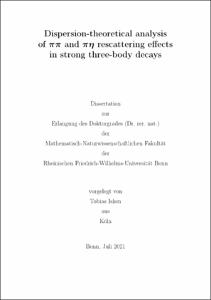Dispersion-theoretical analysis of ππ and πη rescattering effects in strong three-body decays

Dispersion-theoretical analysis of ππ and πη rescattering effects in strong three-body decays

| dc.contributor.advisor | Kubis, Bastian | |
| dc.contributor.author | Isken, Tobias | |
| dc.date.accessioned | 2021-10-08T13:04:24Z | |
| dc.date.available | 2021-10-08T13:04:24Z | |
| dc.date.issued | 08.10.2021 | |
| dc.identifier.uri | https://hdl.handle.net/20.500.11811/9348 | |
| dc.description.abstract | Employing dispersion theory to analyse hadronic three-body decays is a classic subject. Based on the fundamental physical principles of analyticity and unitarity, dispersion relations exploit basic theorems of complex analysis to provide a mathematical toolkit that describes the analytic structure of the amplitude in terms of integral equations. Since the resummation of the leading final-state rescattering effects among the three decay products is implemented by construction, an application is of particular interest for processes of the strong interaction at low energies, where a perturbative expansion of quantum chromodynamics fails. In this thesis we present a dispersion-theoretical analysis of hadronic three-body decays based on integral equations of the Khuri—Treiman type. The η' → ππη decay offers several features of interest: due to the small available phase space it can be used to constrain πη rescattering at low energies, in the soft-pion limit current algebra predicts two Adler zeros in the unphysical region, and the neutral η' → π0π0η Dalitz-plot distribution is expected to show a cusp effect at the π+π- threshold. Restricting ourselves to the dominant S-wave discontinuities, our dispersive representation of η' → ππη is based solely on the ππ and πη S-wave scattering phase shifts. Isospin symmetry dictates that both the charged and neutral decay modes η' → π+π-η/π0π0η are given in terms of the same amplitude. The subtraction constants contained in the dispersion relation are determined by a fit to experimental data of the η' → π+π-η Dalitz-plot distribution from the VES and BESIII collaborations. In accordance with the soft-pion theorem our amplitude exhibits two Adler zeros. We compare the dispersive representation to variants of chiral perturbation theory and provide a prediction for the cusp effect in the η' → π0π0η Dalitz-plot distribution. Patterns of C- and CP-violation from mirror symmetry breaking in the Dalitz-plot distribution of the η → π+π-π0 decay offer an ideal arena in the search for physics beyond the standard model. Effects of this kind are particularly interesting as they are not directly constrained by limits on electric dipole moments. Determined by the isospin coupling of the three pions in the final state, the amplitude can be decomposed into an isoscalar, isovector, and isotensor structure. Based on the dispersive framework, we present a consistent description of these isospin amplitudes allowing for contributions of ππ S- and P-waves to the discontinuities. We compare the dispersive representation to experimental data of the η → π+π-π0/3π0 Dalitz-plot distributions from the KLOE-2 and A2 collaborations as well as constraints of standard chiral perturbation theory. Furthermore, our dispersion relation allows us to give bounds on effective coupling strengths of the underlying operators beyond the standard model. Decays of light isoscalar vector mesons into three pions provide an ideal test case for dispersion relations. Due to Bose symmetry only odd partial waves are allowed to contribute, so neglecting discontinuities of F- and higher partial waves, the decay is fully described by the ππ P-wave rescattering effects. In the context of two-body resonances, like the ρ(770), unitarized versions of chiral perturbation theory offer a way to investigate resonance properties and their quark-mass dependence. Three-body resonances like the ω(782) cannot be accessed in such a formalism. We study the quark-mass dependence of ω → 3π decays within the dispersive framework, relying on the ππ P-wave scattering phase shift extracted from unitarized chiral perturbation theory. The described formalism may be used as an extrapolation tool for lattice QCD studies of three-pion decays, for which ω → 3π serves as a paradigm case. | en |
| dc.language.iso | eng | |
| dc.rights | In Copyright | |
| dc.rights.uri | http://rightsstatements.org/vocab/InC/1.0/ | |
| dc.subject | Dispersionsrelationen | |
| dc.subject | Starke Wechselwirkung | |
| dc.subject | Chirale Symmetrie | |
| dc.subject | Zerfälle leichter Mesonen | |
| dc.subject | Dalitz-Diagramm Analyse | |
| dc.subject | C- und CP-Verletzung | |
| dc.subject | Quark Massen | |
| dc.subject | dispersion relations | |
| dc.subject | strong interactions | |
| dc.subject | chiral symmetry | |
| dc.subject | light meson decays | |
| dc.subject | Dalitz-plot analysis | |
| dc.subject | C- and CP-violation | |
| dc.subject | quark masses | |
| dc.subject.ddc | 530 Physik | |
| dc.title | Dispersion-theoretical analysis of ππ and πη rescattering effects in strong three-body decays | |
| dc.type | Dissertation oder Habilitation | |
| dc.publisher.name | Universitäts- und Landesbibliothek Bonn | |
| dc.publisher.location | Bonn | |
| dc.rights.accessRights | openAccess | |
| dc.identifier.urn | https://nbn-resolving.org/urn:nbn:de:hbz:5-64007 | |
| ulbbn.pubtype | Erstveröffentlichung | |
| ulbbnediss.affiliation.name | Rheinische Friedrich-Wilhelms-Universität Bonn | |
| ulbbnediss.affiliation.location | Bonn | |
| ulbbnediss.thesis.level | Dissertation | |
| ulbbnediss.dissID | 6400 | |
| ulbbnediss.date.accepted | 29.09.2021 | |
| ulbbnediss.institute | Mathematisch-Naturwissenschaftliche Fakultät : Fachgruppe Physik/Astronomie / Helmholtz-Institut für Strahlen- und Kernphysik (HISKP) | |
| ulbbnediss.fakultaet | Mathematisch-Naturwissenschaftliche Fakultät | |
| dc.contributor.coReferee | Meißner, Ulf-G. | |
| ulbbnediss.contributor.orcid | https://orcid.org/0000-0003-2067-7353 | |
| ulbbnediss.contributor.gnd | 1246294982 |
Dateien zu dieser Ressource
Das Dokument erscheint in:
-
E-Dissertationen (4395)




